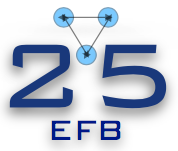Speaker
Description
We would like to show one more fruitful application of the clothed-particle notion in the theory of electromagnetic interactions with nuclei. A constructing element of our consideration is the Campbell–Hausdorff expansion formula applied to the initial Noether current density operator
$\phantom{Eq. (1)} J^{\mu}(0) = e^R J^{\mu}_{c}(0) e^{-R}=J^{\mu}_{c}(0)+[R,J^{\mu}_{c}(0)]+\frac{1}{2}[R,[R,J^{\mu}_{c}(0)]]\,+\,...,$
(see Eq. (5.16) in [1]), where $J^{\mu}_{c}(0)$ is the current density operator in which the bare operators $\{\alpha\}$ are replaced by the clothed ones $\{\alpha_{c}\}$ and $ R $ the corresponding generator of the unitary clothing transformation. This decomposition can be split into the one-nucleon
$\phantom{Eq. (2)} J_{1N}^\mu(0)= \int d\mathbf{p}^\prime d\mathbf{p}\, F^\mu(\mathbf{p}^\prime,\mathbf{p}) b_c^\dagger(\mathbf{p}^\prime)b_c(\mathbf{p}), $
two-nucleon
$\phantom{Eq. (3)} J_{2N}^\mu(0)= \int d\mathbf{p}^\prime_1 d\mathbf{p}^\prime_2 d\mathbf{p}_1 d\mathbf{p}_2\, F_{MEC}^\mu(\mathbf{p}^\prime_1,\mathbf{p}^\prime_2,\mathbf{p}_1,\mathbf{p}_2) b_c^\dagger(\mathbf{p}^\prime_1)b_c^\dagger(\mathbf{p}^\prime_2)b_c(\mathbf{p}_1)b_c(\mathbf{p}_2) $
and more complicated current density operators, whose matrix elements being sandwiched between the strong Hamiltonian eigenvectors from the subsector of the full Fock space without clothed mesons determine the radiative amplitude of interest. Transition to these eigenvectors is regulated via the Okubo-Glöckle method [2, 3]. Special attention is paid to finding the two-nucleon contributions
$\phantom{Eq. (4)} J_{2N}^\mu= \frac{1}{2}[R,[R,J_c^\mu(0)]]_{\textrm{two-nucleon}} + O(g^4) $
that can be interpreted as a meson exchange current. It is important to stress that the many-nucleon currents introduced in such a way do not depend on the choice of states with which we calculate the matrix elements. The new meson exchange currents have been compared with those obtained relying upon the Dyson-Feynman series for the $S$ operator in the bare-particle representation. In our other contribution to the conference, we would like to show the application of these new currents to calculate the deuteron electromagnetic form factors.
References
1. A. Shebeko and M. Shirokov, Prog. in Part. and Nucl. Phys. 44, 75 (2000).
2. S. Okubo, Prog. Theor. Phys 12, 603 (1954).
3. W. Glöckle, L. Müller, Phys. Rev. C 23, 1183 (1981).

